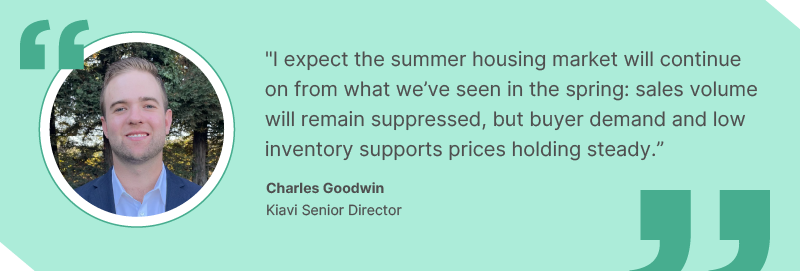
What the 2023 Summer Housing Market Tells Us About Future Growth
Sunshine, warm weather, and endless afternoons typically make summer a prime season for movement in the real estate housing market. But between spiked mortgage rates and home prices[1] signaling an economic downturn[2], it’s natural to wonder whether now is a smart time to invest.
What can the current trends tell us about what to expect in 2024? We spoke with Kiavi Senior Director Charles Goodwin to break down the latest market reports and get his best tips on how new and small-time investors can prepare today to stay ahead of the curve.
Top 3 housing trends to watch in 2024
1. Mortgage standoff: Homeowners cling to low rates, leaving short supply
“I’m not giving up my 3% mortgage rate” is the consensus among many homeowners holding onto their properties amid the current climate of volatile mortgage rates hovering within the 6.25% to 7.00% range[3], and that’s keeping supply very low.
According to a recent report from Fannie Mae’s (FNMA/OTCQB) Economic and Strategic Research (ESR) Group[4]: “This is due in large part to the ‘lock-in effect,’ in which existing homeowners are disincentivized from listing their homes and potentially giving up their lower mortgage rate. Still, strong demand for housing remains supportive of home prices, although the ESR Group notes significant regional variation in actual and expected home price movements.”  Buyers looking to purchase a property this summer should still have options, says Goodwin—just don’t expect a dramatic increase in supply. “I expect the summer housing market will continue on from what we’ve seen in the spring: sales volume will remain suppressed, but buyer demand and low inventory support prices holding steady.”
Buyers looking to purchase a property this summer should still have options, says Goodwin—just don’t expect a dramatic increase in supply. “I expect the summer housing market will continue on from what we’ve seen in the spring: sales volume will remain suppressed, but buyer demand and low inventory support prices holding steady.”
2. Defying the odds: Consumer power prevails
Despite soaring mortgage rates and interest rate hikes from the federal government challenging affordability, the economy remains resilient with more than enough demand from consumers. Homebuyers looking to purchase a new property will benefit from using downtime in the volatile market to get pre-approved by lenders and aggressively watching shifting rates so they can make an immediate offer when the opportunity strikes[5].
3. Rising titans: New home builders forge ahead
Fueled by a combination of low resale supply and strong balance sheets, the dominance of new home builders in the current market sets the stage for continued growth. With the limited availability of existing homes, buyers are increasingly turning to new construction, providing a significant advantage to builders who are well-positioned to expand their operations and market presence. Backed by the financial capacity to invest in new projects and meet the rising demand, big builders are likely to consolidate their market position further and increase their market share, cementing their dominance in the industry.
Getting the market advantage
Believe it or not, all property types can provide excellent returns if purchased at the right price, Goodwin says. But which properties have the most potential? Currently, single-family homes have a buyer advantage in emerging real estate markets.
“I personally believe single-family residences will hold up better than an asset class like multi-family because of the lookahead supply dynamics,” he says. “There are a substantial number of multi-family properties under construction right now that will be delivered over the next two years but not nearly as many single-family construction projects in progress.”
Affordability continues to drive the market as average housing payments relative to income remain stretched. According to the Center for Real Estate Excellence at the Federal Reserve Bank of Atlanta’s Home Ownership Affordability Monitor (HOAM), 2023 marked some of the lowest national affordability since 2007[6].
Goodwin suggests that investing in more affordable markets could hold demand for both resale properties and rentals, preferably in the South (except Miami) and Midwest, versus expensive markets such as the West Coast. For example, Scranton, P.A., Des Moines, I.A., Toledo, O.H., and St. Louis, M.O. rank among the top metro area markets for most affordability, according to the HOAM report.
Staying ahead of the curve
Highs and lows are to be expected in the real estate market, with seasonal properties offering both high risk and the potential for high reward no matter when you invest. But a lull in the market isn’t a time for rest—it’s an opportunity to get strategic.  To get ahead, Goodwin recommends good ol’ fashioned networking with other area investors. “Success in residential real estate is all about who you know,” he says. “Whether it's sharing advice, contacts for contractors, or passing along possible deals, it's important to get out there in your community.”
To get ahead, Goodwin recommends good ol’ fashioned networking with other area investors. “Success in residential real estate is all about who you know,” he says. “Whether it's sharing advice, contacts for contractors, or passing along possible deals, it's important to get out there in your community.”
It’s also essential to weigh the potential risks, benefits, and timing of investing. Flippers may expect typical seasonal softness in the buying pool for fall and winter. At the same time, Airbnb investors may want to watch out for possible regulatory changes and possibly be prepared to exit via sale or pivot to long-term rentals. Goodwin cites a recent full ban passed by the Dallas City Council for short-term rentals (STR) in all residential areas as a prime example of what’s to come.
“They won’t grandfather in existing permits,” he says. “The legislation will likely be contested in court, but it is representative of the scrutiny facing seasonal rentals and the regulatory risk that comes with STRs. However, these can be excellent rentals, so do your diligence wisely.”
The bottom line
To make sure you get the best ROI, Goodwin says it’s important to be transparent about your situation and what you’re looking to accomplish. A Kiavi sales rep can help guide you through the best possible outcomes when it comes to cost and interest rates. The availability of capital for lenders in this space remains very uncertain, but having a reliable lender like Kiavi can provide reassurance that your deal will get funded. In a market where investors are less active, ensuring funding on each deal matters that much more.
Overall, these market trends suggest that the housing market will continue to face supply constraints in the near future. However, consumer demand and the prowess of new home builders are expected to drive growth, potentially leading to further price appreciation and opportunities within the industry. Monitoring these trends will be crucial for stakeholders seeking to navigate the evolving housing market landscape.
Sources:
1 Lance Lambert, "What to expect next from the housing market,"Fortune. May 10, 2023
2 Jean Folger, "How to prepare for a potential recession in 2023," SFGate. July 6, 2023
3 Jean Folger, "Housing market predictions for summer 2023," SFGate. May 30, 2023
4 Fannie Mae, "Economy Resumes Gradual Slowdown Following Bank Turmoil," April 21, 2023
5 Swapna Venugopal Ramaswamy, "The Fed's inflation-fighting tactic was effective in cooling the housing market. What now?" USA Today. June 5, 2023.
6 Federal Reserve Bank of Atlanta, "Home Ownership Affordability Monitor," n.d.